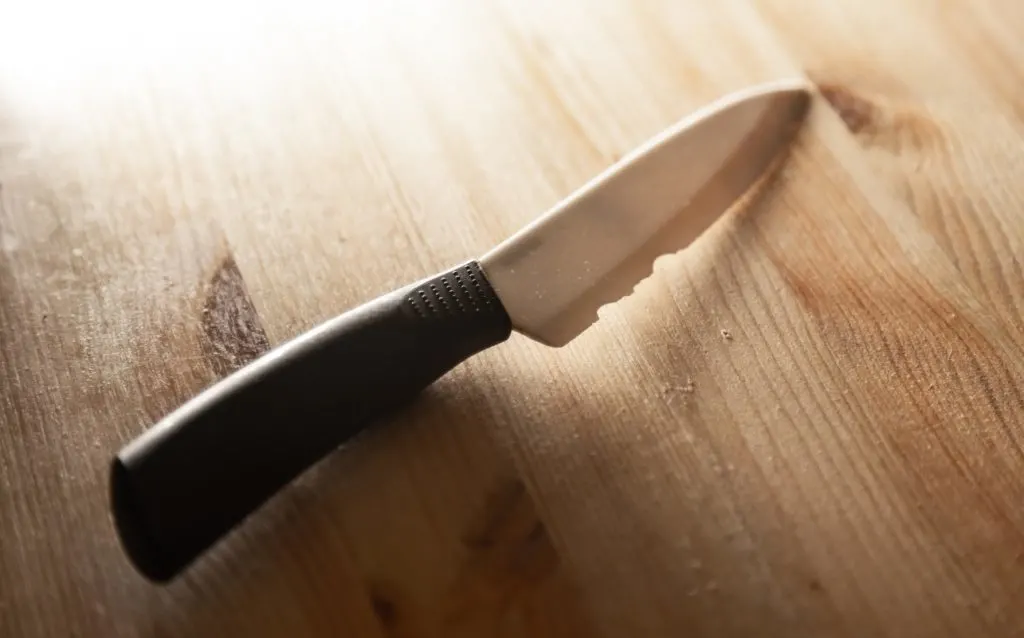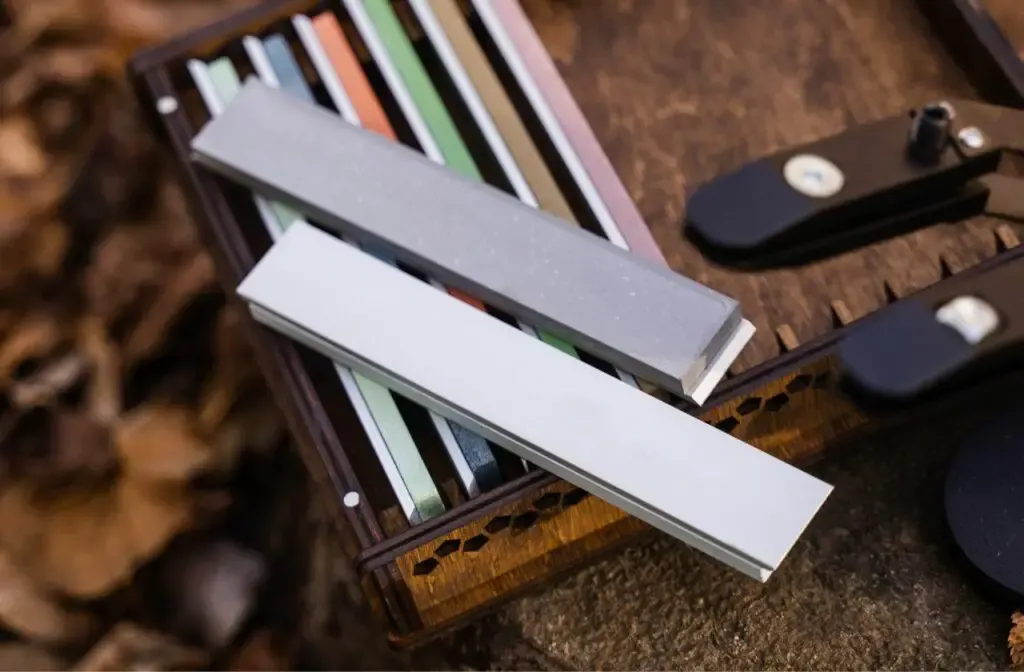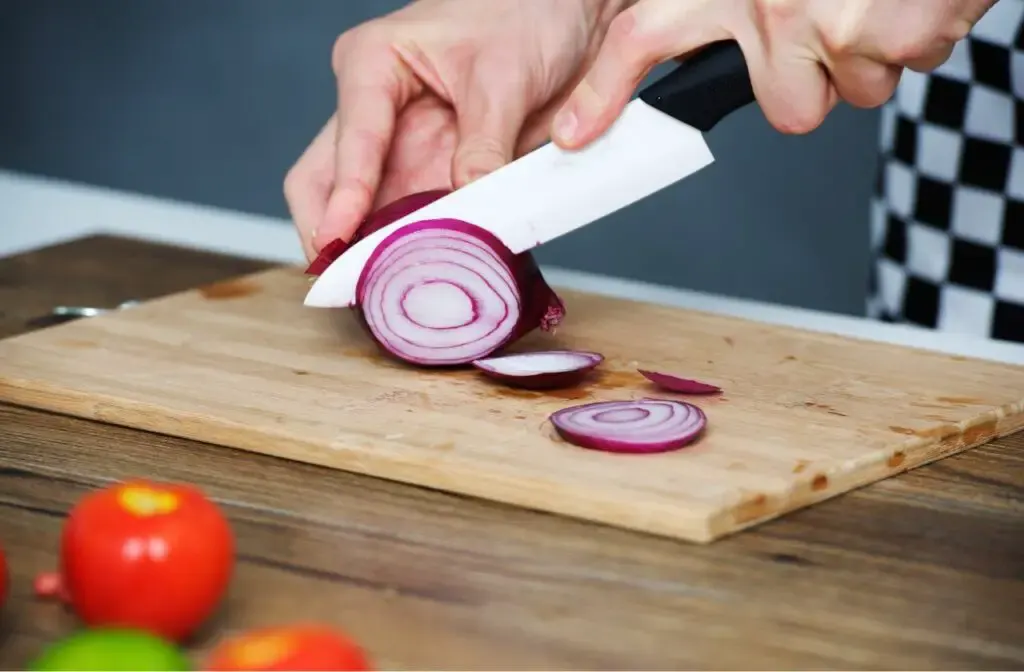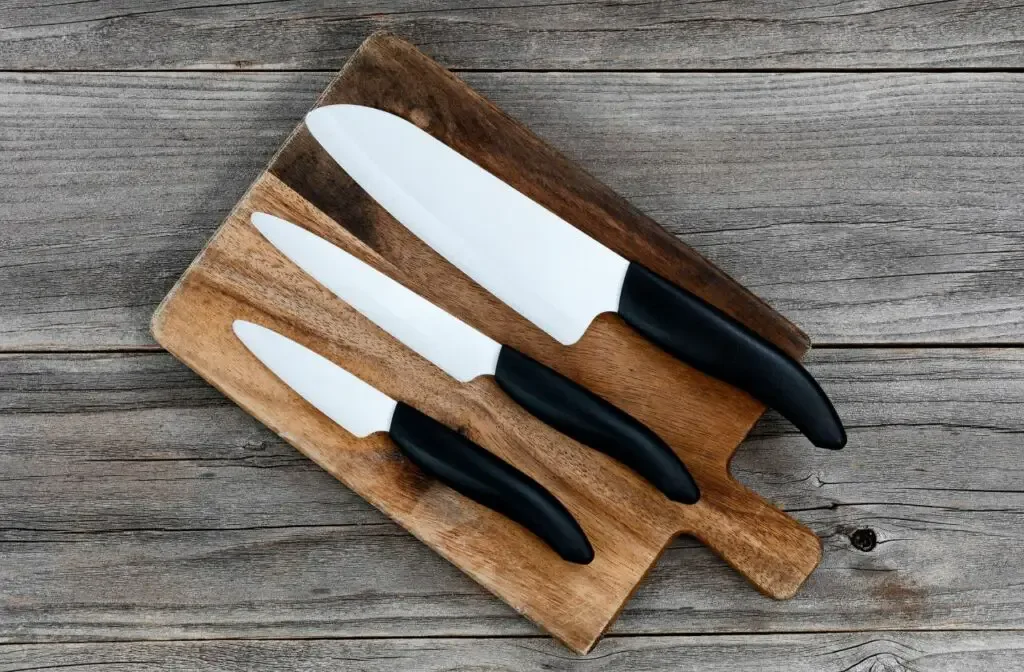As an Amazon Associate, we earn from qualifying purchases with no additional costs for you.
Ceramic knives are a pleasure to use in the kitchen, especially for processing soft ingredients. Their superior sharpness gives clean, precise cuts without bruising or crushing the ingredients. These knives may be great to use, but they are prone to cracks and chips. How can you fix a chipped ceramic knife?
Diamond stones can be used to fix chipped ceramic knives if the chip is not too severe.
- Coarse, medium, and fine diamond stones are needed.
- Use the coarse stone to grind out the chip.
- The medium stone will be used to re-establish the edge.
- Use the fine stone to refine the edge.
Ceramic knives are not your run-of-the-mill steel kitchen knives and require different maintenance and care in their use. Fixing a chipped steel knife is relatively easy if you have whetstones available, but what can you do about a chipped ceramic knife? Is it fixable, or should you look for a new knife?
If you are interested in checking out the best diamond sharpening stones (Atoma) for sharpening ceramic knives you can find them by clicking here (Amazon link).

Do Ceramic Knives Chip Easily?
Ceramic knives are made from an extremely hard material called zirconium dioxide. The advantage of this hard material is that the ceramic knife can hold an extremely sharp edge and remain sharp longer than most steel knives.
The disadvantage of zirconium dioxide is that along with the hardness of the material, it is also very brittle and can chip, crack, or snap very easily.
What Causes A Ceramic Knife To Chip?
Although the ceramic knife material is very hard and can be sharpened to a very thin edge, the hardness makes the knife very stiff and inflexible. This makes the knife incapable of absorbing impact or twisting or flexing motions without introducing cracks and chips into the knife blade.
Ceramic knives can chip and crack through normal use, but the following are the most common causes of chips in the blade.
- Dropping the knife. The impact of dropping the knife on the floor or on a hard kitchen countertop can crack, chip, or snap the blade.
- Cutting on a hard surface. Using a ceramic knife to cut ingredients on a hard cutting board, such as granite, glass, ceramic, or steel, can chip and crack the knife’s cutting edge. As the knife cuts through the ingredients and contacts the hard surface of the cutting board, the impact can chip the cutting edge.
- Cutting into hard ingredients. Accidentally cutting into bone or the frozen center of food that has not thawed all the way through can chip and crack the ceramic blade.
- Cutting hard-skinned vegetables. These vegetables should not be processed with a ceramic knife. The extra pressure required to cut through the hard skin will damage the knife’s cutting edge and snap the blade in half.
- Twisting in the cut. Ceramic knives must be operated in a straight line cut. Any twisting of the knife causing the blade to flex can chip the blade or cause it to snap and break pieces off the blade.
- Incorrect storage of the ceramic knife. Storing a ceramic knife in a kitchen drawer with other utensils will result in the knife being bashed by the other items in the drawer, causing chipping of the blade.
- Washing a ceramic knife in a dishwasher. Ceramic knives should be washed by hand. The jarring and jostling inside a dishwasher can easily damage a ceramic knife blade.
Even when paying attention to how you use your ceramic knife, you can still pick up chips and cracks on the blade through the normal use of the knife.
Most people know that steel knives with this type of damage can generally be repaired, but what about ceramic knives?
Can You Fix Chipped Ceramic Knives?
If you have a ceramic knife that has sustained damage, you may wonder if the damage is repairable or whether the knife is a lost cause.
The extent of the damage will determine whether the knife can be salvaged or should be discarded. It can generally be repaired if the chip is small and located on the knife’s cutting edge.
If the chip has taken a gouge out of the edge and the damage extends too far up into the main part of the blade, then the damage is generally not repairable. It would require removing too much material from the knife to restore the cutting edge.
Likewise, cracks extending beyond the cutting edge and into the blade’s body cannot be repaired.
Ceramic blades that have snapped may be salvageable in some cases, depending on where the snap has occurred. If the blade has snapped in half, it cannot be repaired. If the tip has snapped off, the knife can be ground shorter to remove the broken section of the tip.
BTW: If you want to know more about Japanese and other knives and their sharpening, check out the books listed above. These books are recommended by professional sharpeners and knife makers (Amazon links):
- Japanese Kitchen Knives: Essential Techniques and Recipes
- The Knifenerd Guide to Japanese Knives
- Knife: The Culture, Craft, and Cult of the Cook’s Knife
- Sharp: The Definitive Introduction to Knives, Sharpening, and Cutting Techniques, with Recipes from Great Chefs
Can You Sharpen A Chipped Ceramic Knife?
A chipped ceramic knife can be sharpened, but you will need specialized equipment to sharpen and repair these knives. The sharpening process will remove small chips from the ceramic knife’s cutting edge.
Sharpening a knife requires an abrasive material that is harder than the material the blade is made from. Ceramic material is harder than steel, so standard whetstones cannot be used to sharpen these knives.
The only material harder than zirconium dioxide is diamond. Consequently, ceramic knives can only be sharpened with diamond stones.
Diamond stones can be used to sharpen ceramic knives and repair chips in the blades cutting edge.
TIP: Ceramic knives certainly hold their edge for a long time, but, like all knives, they do eventually become dull with use. Check out the guide on how to sharpen a ceramic knife in the article below:
Step-By-Step Guide: How To Sharpen A Ceramic Knife
How To Fix Chipped Ceramic Knife?

If the chip in the edge of your ceramic knife is not too severe, you can fix the knife by using diamond stones to repair the damage and restore the cutting edge.
This process will alter the knife and make it smaller since the only way to fix the chip is to grind it out and reprofile the blade.
When sharpening or repairing a ceramic knife, care must be exercised to ensure you do not flex the blade against the whetstone. Applying this kind of pressure will cause the blade to snap.
You can follow these steps to fix a chipped ceramic knife.
1. Select Your Whetstones

You will need a set of diamond whetstones to maintain, fix, and sharpen a ceramic blade. You will need a minimum of 3 stones, a coarse, medium, and fine-grit diamond stone.
The coarse stone will be used to grind out the damage in the knife, and the medium and fine stones will be used to re-establish the knife’s cutting edge.
TIP: Diamond sharpening stones can be an expensive investment for your knife sharpening, which may tempt some people to look for lower-priced products. Check out the complete buyer’s guide in the article below:
Buyer’s Guide: Best Diamond Knife Sharpening Stones Set
2. Start With The Coarse Diamond Stone
Place the coarse diamond stone in a position you would normally use to sharpen a knife. Place the ceramic knife on the whetstone and establish the correct angle for the bevel.
Once you have the correct angle, drag the blade across the stone in the same manner you would use to sharpen a knife.
Work across the whole length of the blade, not only the damaged section. Count your strokes on one side and then flip the knife over and perform the same amount of strokes on the opposite side. This will keep the wear even on both sides of the blade.
Continue working both sides of the blade with the coarse stone until the chip has disappeared from the knife’s edge. Once the chip is no longer visible, it is time to move on to the next grit level.
PRO TIP: We personally use diamond plates by Atoma. They are quite expensive but of the top quality with very long service life.
The initial costs are higher but you have an option of buying replacing diamond skin for all Atoma plates. The costs of replacing diamond skin are much lower than the cost of buying a new diamond plate.
So if you are going to use diamond plates regularly and want to get the best quality on the market, check out the four Atoma diamond plates listed below (Amazon links).
- Atoma Diamond Sharpener Coarse Grade 140 Grit
- Atoma Diamond Sharpener Medium 400 Grit
- Atoma Diamond Sharpener Fine 600 Grit
- Atoma Diamond Sharpener Super Fine 1200 Grit
These 4 diamond sharpening stones are all you need to have for repairing or sharpening your knives.
3. Move Onto The Medium Diamond Stone
Once the chip is removed from the edge of the ceramic blade, it is necessary to re-sharpen the blade and restore it to its original sharpness.
Switch to the medium grit diamond stone. Establish the correct angle to sharpen the edge, which is usually about 20 degrees, and begin sharpening one side of the blade.
It is extremely important to count your sharpening strokes on each side of the blade. A ceramic blade does not give the same tactile feedback during sharpening as steel does, and there is no burr that develops on the opposite edge.
You will need to monitor the progress of the edge by eye rather than feel. This is why performing the same number of strokes on both sides of the blade is important.
4. Switch To A Fine Grit Diamond Stone
Once the edge has been established with the medium stone, it is time to refine the edge on the fine-grit diamond stone.
The technique and angle used on the fine stone are exactly the same as you used on the medium grit stone. Once again, count your strokes on each side and test for desired sharpness after each set of 4 to 5 strokes on each side of the knife.
If you are not happy with the level of sharpness, you can perform a few more strokes on the fine-grit diamond stone or go back to the medium-grit stone to make adjustments before coming back to the fine-grit stone.
TIP: How to use diamond stones to sharpen your knives like a pro? Check out this step-by-step guide on sharpening knives with diamond stones:
DIY Guide: Using Diamond Knife Sharpening Stone Like A PRO
Is It Safe To Use A Chipped Ceramic Knife?

It is not safe to use a chipped ceramic knife. The jagged edge on the blade will cause the knife to hook and catch on the ingredients being cut.
This catching can cause the knife user to exert more pressure to push the knife through the item, resulting in the knife slipping and cutting the user. The undamaged parts of the ceramic knife are still extremely sharp and can inflict a severe cut on the knife user.
FAQs: Understanding Ceramic Knives Better

Ceramic knives are a popular choice in many kitchens due to their sharpness and longevity. However, they come with their own set of unique characteristics that may raise questions for users. Here, we address some of the most common queries about ceramic knives.
Q: How often should I sharpen my ceramic knife?
A: Ceramic knives retain their sharpness longer than most steel knives. However, with regular use, they might eventually need sharpening. Typically, a ceramic knife should be sharpened once a year or when you notice a decrease in its cutting performance. Always use diamond sharpening stones, as they are the only abrasive hard enough to sharpen ceramic.
Q: Are there any foods I should avoid cutting with a ceramic knife?
A: Yes, due to the brittleness of ceramic blades, it’s advisable to avoid cutting hard-skinned vegetables, frozen foods, or bones. Applying excessive pressure or twisting the knife while cutting can lead to chipping or breaking.
Q: Can I store my ceramic knife in a regular knife block?
A: Absolutely! Storing your ceramic knife in a knife block or on a magnetic strip is ideal. Avoid placing it in a drawer with other utensils, as this can lead to chipping.
Q: Is it safe to wash my ceramic knife in a dishwasher?
A: While ceramic knives are resistant to chemicals and acids, it’s best to hand-wash them. The forceful water jets and potential contact with other utensils in a dishwasher can damage the blade.
Q: What should I do if my ceramic knife breaks in half?
A: If your ceramic knife breaks into two pieces, it’s generally not repairable. For safety reasons, it’s best to discard the broken knife and consider purchasing a new one.
Q: Why is ceramic used for knives?
A: Ceramic, specifically zirconium dioxide, is used because of its hardness. It can hold an extremely sharp edge and remains sharp longer than most steel knives. However, this hardness also makes it brittle, which is why care is needed during use.
Q: Can I use a steel honing rod for my ceramic knife?
A: No, steel honing rods are not suitable for ceramic knives. If you wish to hone your ceramic knife, use a honing rod made of diamond.
Conclusion
A chipped ceramic knife can be repaired in many cases, but the only abrasive capable of performing the repair is a diamond abrasive. This is the only material hard enough to cut the ceramic material to grind out the damage and re-sharpen the blade.
The process can take some time to achieve a good result because of the hardness of the ceramic material. Some knife sharpening services also offer ceramic knife repair, but you can expect this to be more expensive than a repair on a steel knife.
TIP: Since the purpose of a dishwasher is to clean dishes and cutlery, it seems counter-intuitive that the machine can damage knives. Check out why dishwashers ruin knives in the article below:
Guide: Why Dishwashers Ruin Knives & What Knives Are Safe

